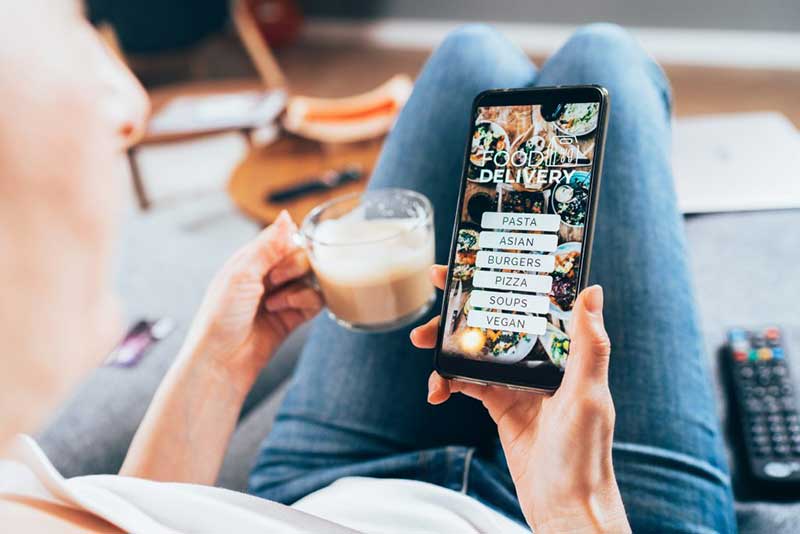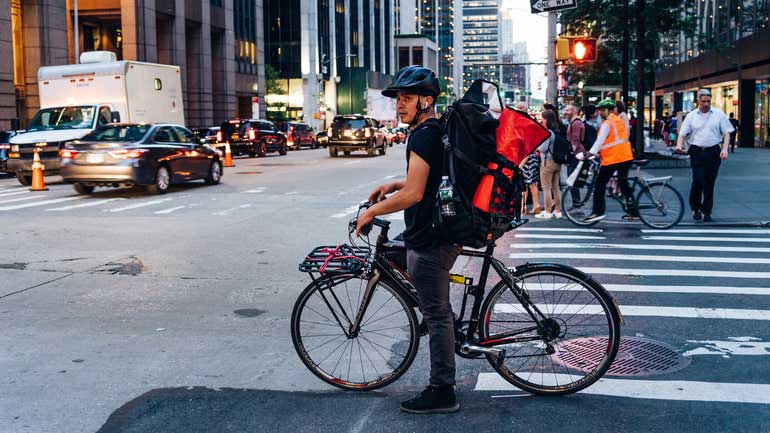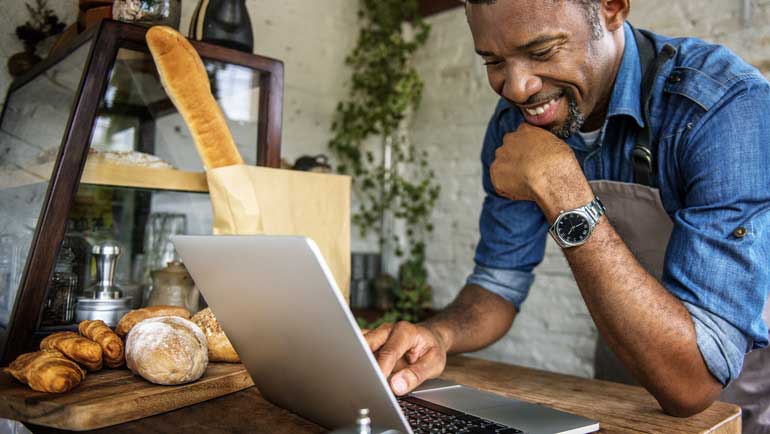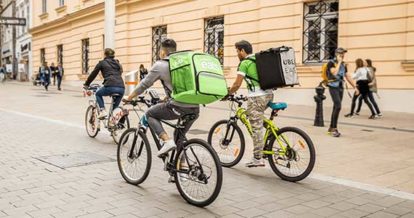Home to more than eight million people, New York City has always been a technology and trend epicenter. In the wake of the coronavirus pandemic and nation-wide shutdowns of restaurant dining rooms, online ordering and food delivery in NYC has been critical for both New York restaurants and their customers.
With many people searching for “delivery apps NYC” and restaurants rushing to adopt the latest online ordering system, there are many options to choose from. They might not all be right for your specific venue needs, but you may find one or two that are the right restaurant delivery service for your restaurant.
Plus, integrating a restaurant online ordering system and takeout options into your business model could help you weather the COVID-19 challenges by increasing your bottom line and growing your customer base.
In this article, we’re going to cover:
- What are third-party delivery apps?
- The top food delivery apps in NYC
- Alternatives to third-party apps
What Are Third-Party Delivery Apps?

Third-party delivery and takeout apps are marketplaces for restaurants, a kind of directory sorted by location and food type, letting customers browse and order from individual menus on their phone or desktop.
Acting as a virtual food hall, a third-party app is the middle man that gets you in front of hungry customers in your area who are ready to order.
While some of these apps focus on order-ahead takeout that customers pick up, most offer independent contractors that will deliver food from your restaurant directly to the customer, which means you don’t have to hire, train, and pay for drivers.
If you’re looking to keep more of the operations – and profit – in house, you could opt for direct online ordering (on your own website) instead of third-party apps, but this would mean either offering pickup only on these orders or hiring your own delivery fleet. Since some dining rooms are still closed or operating with reduced capacity, certain restaurants have retrained their furloughed front-of-house staff as temporary delivery drivers.
The Dark Side of Food Delivery and Takeout Apps
Third-party apps have seen huge growth in 2020, with online ordering rising by more than 25% since the start of the pandemic and 78% of consumers ordering online as frequently or more often than before.
However, even the best food delivery app isn’t without controversy. Many take up to a 30% commission on all transactions, on top of monthly fees, which makes it difficult to turn a profit on these orders unless you’re dealing with large volumes of orders.
For an industry with razor-thin margins already and suffering through the challenges of COVID-19, third-party apps could be doing more harm than good – so much so that New York City imposed a temporary cap on commissions at 15% and on marketing contributions or other related fees at 5%.
There’s also a new class-action lawsuit against several third-party food delivery services.
What Are the Most Popular Delivery Apps in NYC?

By June of 2020, sales for meal delivery apps have more than doubled year-over-year. Up until 2018, Grubhub dominated most of the U.S., with acquisitions of Eat24 and Seamless. This app continues to be the most popular food delivery app in Northeastern metropolitan areas, including Boston and New York City.
But DoorDash has made huge leaps forward in the last year, seeing the fastest growth in usage – a 33% increase – between February and November of 2019 and leading the country with a 45% share of sales in the U.S. as of June this year.
Here’s how delivery apps stack up in usage in NYC:
Grubhub – 52%
UberEats – 25%
DoorDash – 21%
Other – 2%
This is particularly important to note because not only are customers using third-party delivery more often, half of them are using more than one app to do it. So if you’re thinking about how to market your restaurant, keeping a close eye on the success of your delivery channels is important to ensure you’re reaching your customers where they are.
The Top Food Delivery Apps in NYC
1. Grubhub
After acquiring Seamless, Eat24 – and its own acquisition by Just Eat Takeaway – Grubhub has become a powerhouse for online and mobile food ordering with over 22.6 million users worldwide.
Consumers can filter their search results by cuisine, price point, features such as coupons and delivery tracking, and customer ratings.
Consumers can also choose either delivery or pickup, with both options offering them an estimated time of arrival or pickup. They can also save multiple delivery locations within the app.
Availability: Download for iOS and Android; Grubhub is available in over 3,200 cities in the U.S.
Customer Fees: $3.99 delivery fee, plus a varying percentage service fee depending on the size of your order.
Restaurant Commission Fees: The base commission rate for Grubhub orders is 10% plus a processing fee of 3.05% + $0.30. An additional 20% marketing fee applies as well.
Subscription: Grubhub+ is a $10 per month subscription service that waives the customer delivery fee for participating restaurants.
Coronavirus Update: Grubhub offers contact-free delivery, including an order pickup option for people who are more comfortable picking up the food themselves. Customers can select the delivery option at checkout and leave specific instructions for their driver.
They’ve also established the Grubhub Community Relief Fund, which allows customers to round up their order to the nearest dollar. The extra virtual “change” is donated to charitable organizations that support local restaurants and drivers impacted by the pandemic.
Customers can also take advantage of their Supper for Support initiative to receive $10 off their order of $30 or more, available at participating restaurants from 5pm to 9pm.
2. Uber Eats
More than 75 million people worldwide use Uber. It’s a quick and easy way to get around and eliminates the need to wait a long time or stand in the street trying to hail a taxi. Leveraging its success in ridesharing, Uber Eats is especially brilliant, utilizing its fleet of drivers to deliver food door-to-door.
Because of the size of its fleet, it can service some smaller cities as well, making this particularly useful for restaurants that don’t already have delivery integrated into their operation.
Uber Eats had already been a popular food delivery app on its own, but has secured a stronger foothold on the meal delivery market with its recent acquisition of Postmates.
The app is very user friendly and sorts restaurants by customer location and food available nearby. This means as long as your restaurant is open and on the app, you will be listed in local food options giving you a chance to reach customers who may have otherwise overlooked your restaurant. The app also highlights estimated delivery times and allows for cashless transactions.
Availability: Download on iOS and Android; Uber Eats services over 3,000 cities in the U.S.
Customer Fees: A service fee of 15% of an order’s subtotal and usually includes a small order fee for orders under $10.
Restaurant Commission Fees: Varies, between 20% and 30% before the temporary cap was implemented.
Subscription: Eats Pass is Uber Eats’ answer to the rise of subscription services. $10 per month gives customers $0 delivery and 5% off orders over $15 for participating restaurants.
Coronavirus Update: Contactless delivery is now standard and Uber Eats provides its delivery drivers with more safety training, assistance, and tools to minimize risk of exposure.
3. DoorDash
The fastest growing food delivery app in the country, DoorDash boasts over 310,000 restaurants located in 4,000 cities around the world. DoorDash isn’t quite as widely available as Grubhub yet, but it’s getting there.
Search functions allow users to search by types of food (burgers, vegetarian, Mexican cuisine and more) or by rating level, price, and delivery under 30 minutes.
It has a Featured Restaurant Partners section with larger chains, including Cheesecake Factory and Chipotle. The app also offers deals like no delivery fees for your first order and the option to try restaurants outside your immediate neighborhood.
Availability: Download for iOS and Android; DoorDash services over 800 cities in the U.S.
Customer Fees: Vary by restaurant but typically include a $3 delivery fee and $3 service fee on top of the price of a meal and taxes.
Restaurant Commission Fees: Approximately 20% per order
Subscription: DashPass provides a $0 delivery fee and reduced service fees on orders of $12 or more, through participating restaurants at a price of $10 per month.
Coronavirus Update: Contactless delivery is now the default option on all orders. DoorDash CEO and co-founder, Tony Xu, also announced a “package of commission relief and marketing support” to help ailing restaurants and they’ve implemented programs to provide financial assistance and health protection for delivery drivers.
4. Postmates
Postmates, already a very popular delivery app with consumers because it offers more than just food delivery – including alcohol – will now have the advantage of sharing its data with Uber Eats since the recent acquisition.
That breadth of data will allow each platform to make more relevant offers to their customers – at least until Uber Eats fully absorbs Postmates into the brand. For now, the two will operate independently.
For restaurateurs, Postmates is easy to use. Like Uber Eats, they have their own delivery staff who work around the clock to bring consumers food anytime, anywhere. All you have to do is sign up, set up your menu, and prepare the food – Postmates will handle the rest.
For consumers, Postmates is similar to Delivery.com in that it’s an all encompassing delivery system offering near instant gratification for everything from food deliveries to birthday presents to cleaning supplies.
Availability: Download on iOS and Android; Postmastes is currently available in more than 4,200 U.S. cities.
Customer Fees: Vary, up to $10, depending on what time an order is placed, with Blitz Pricing for peak hours.
Restaurant Commission Fees: Varies between 15% and 30%
Subscription: Postmates Unlimited is a subscription service for $10 per month, allowing free delivery from select stores and restaurants on all orders more than $12.
Coronavirus Update: Offers contactless delivery and the opportunity for customers to report if their delivery driver appears ill. Postmates has also set up a Fleet Relief Fund to help their employees with any COVID-19-related medical expenses.
5. Delivery.com
Unlike the other food delivery apps in this list, Delivery.com doesn’t employ a fleet of delivery drivers. Instead, it provides a platform to be used for you to facilitate online ordering and your own delivery.
This site goes beyond offering just food in its delivery, allowing customers to get things like groceries delivered, alcohol and even dry cleaning. It’s a one-stop-shop, like Postmates, for customers to get whatever they need at a moment’s notice.
Also, because of its cross-country popularity, Americans who are coming to New York City for business or pleasure and are already Delivery.com users can default to this option if they choose to order in.
Availability: Use it online, or download on iOS and Android; Delivery.com operates in 100 cities across the U.S.
Customer Fees: The app is free to use, with restaurants charging delivery fees and ordering minimums.
Restaurant Commission Fees: Approximately 15%
Subscription: They do not offer a monthly subscription service like the other delivery apps on this list, but instead have a loyalty and rewards program, allowing customers to collect points on their purchases.
Coronavirus Update: Delivery.com has implemented several initiatives to support their partner organizations, like matching contributions from users for example, and protect drivers through contactless delivery and additional safety training. They have even been assisting healthcare workers by raising funds for meal donations to local hospitals.
6. ChowNow
ChowNow boasts commission-free online ordering for restaurants – a welcome tool during the coronavirus pandemic. Their approach works for restaurants in two ways. First, by powering the online ordering systems for over 14,000 restaurants across North America, via their own websites – an increasingly popular option for food delivery apps.
Second, by including seamless integrations into a restaurant’s social tools, including Facebook, Instagram, and Google, which lets customers order through the channels they’re already on.
ChowNow also uses a discovery app, so customers can search for available restaurants in their area, or browse restaurants based on food type. This app can give you customer insights and marketing support. For additional branding and exposure, you can even create a customized ChowNow app with your own logo and branding.
Availability: Order online or download on iOS and Android; ChowNow is available in all major metro cities across the U.S., partnering with over 14,000 restaurants.
Customer Fees: Vary based on the restaurant and location. Pricing is transparent to customers before they complete their order.
Restaurant Commission Fees: No commissions on any orders, working instead on a monthly or annual plan, starting at $99 per month plus set-up fee on a two-year commitment.
Subscription: No monthly subscription services for customers.
Coronavirus Update: Though founded in 2011, their service and mission to help restaurants is even more important now – commission-free online ordering for restaurants and transparent pricing to ensure restaurants are keeping more profits during this challenging time.
They’ve also implemented contactless pickup and delivery through their own fleet of delivery drivers.
Alternatives to Third-Party Delivery Apps

Offering takeout and delivery are key to survival these days. Though third-party apps could help alleviate some of the challenges, it’s important to note that the higher fees – up to 30% in some cases – can make it difficult to turn a profit.
Restaurateurs also have less control over the customer experience through these apps and are operating in a crowded marketplace, making it difficult to stand out when customers have so many options in a single app.
For these reasons, many restaurants are opting for direct online ordering right through their own website – so they can offer convenience, while maintaining profitability and control.
Accepting orders through our own site means you keep 100% of the profits because there’s no middle man. You also get to use more of your own team, allowing them to cross-train in new skills such as preparing food packaging for takeout, and keeping them employed as delivery drivers and pickup coordinators.
Your brand, marketing efforts and offers will extend through your delivery operation, helping you improve the customer experience and reduce order errors.
Delivery Apps Are Here to Stay
One thing is for sure and it’s that online ordering software and delivery apps are here to stay for the foreseeable future. Even as parts of the country have reopened, consumer confidence is still out to lunch with only about half of customers planning to dine out as often as they were before. Meaning more nights in, and more orders placed online.
The convenience for busy New Yorkers is hard to argue, so delivery apps and online ordering will continue to remain one of the key ways restaurants stay in business and find ways to generate revenue until we get back to normal.
Free online ordering signs for your restaurant
Sign up for our free weekly TouchBistro Newsletter







